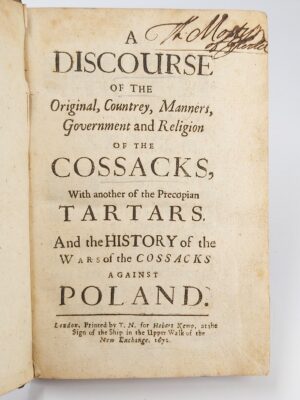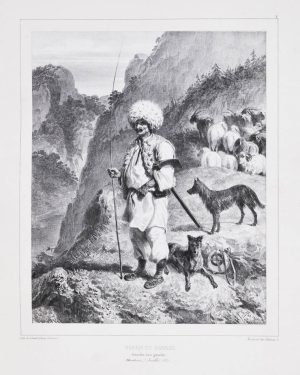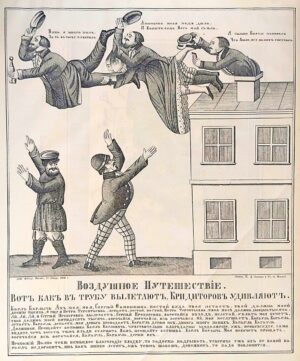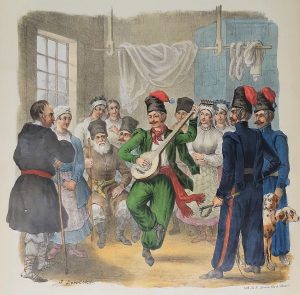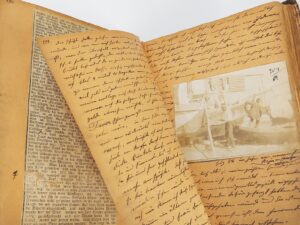Our Notes & References
One of the earliest substantial acknowledgements of the Ukrainian nation in English: first English edition of this important history of 17th-c. Ukrainian Cossacks, “a leading force in the Ukrainian national renaissance” (Plokhy), written by one of the their commanders.
The eldest son of Sir Thomas Browne, Edward Browne (1644-1708) was a physician to King Charles II and president of the Royal College of Physicians. After his extensive travels across Europe he translated into English and organised the publication of Histoire de la guerre des Cosaques contre la Pologne. Avec un discours de leur origine, pays, mœurs, gouvernement et religion (1663 and 1668) by Pierre Chevalier, a commander of a detachment of Cossacks recruited by the French government in Ukraine in 1646. He then served in the French army from 1648 to 1654 and was a secretary to the French ambassador in Poland.
In this valuable source on the history of Ukraine, Chevalier recounts in detail the events he witnessed during the Cossack uprising resulting in the Cossack-Polish War of 1648–54. The work brings together a wealth of ethnographic materials on Ukrainians and different types of Tatars in the region.
As the Cossacks’ uprising of 1648 “brought the largest European state, the Polish Lithuanian Commonwealth, to near disintegration” (Sysyn), it drew great attention to the activities of the Hetman of the Zaporozhian Host Bohdan Khmelnytsky (1595-1657) and to Ukraine, or “the borderland of the Polish state [which] was still a terra incognita” (Sysin). The uprising ended the Polish Catholic szlachta′s domination over the Ukrainian Orthodox population and led to the creation of an independent Cossack state in Ukraine. This victory was an important milestone in the Ukrainian history and culture, and the “Cossackdom became the generally recognized and official guardian and protector of Ukrainian ecclesiastical life—and thus also of Ukrainian cultural and national life” (Hrushevsky, quoted by Plokhy).
Browne describes Khmelnytsky with admiration in his preface: “The Actions of Kmielniski, General of the Cossacks, are very remarkable; and how he raised himself to that greatness, as to be feared by a Nation [of Poland], which neither the Power of Christendom, nor the Turks could shake”. Overall, English official circles were “especially interested in the Cossacks as potential allies in their conflict with the European Catholic states, including the Polish-Lithuanian Commonwealth” (Dobriansky-Demkovych). Browne highlights that “most have their eyes upon this Countrey at present” and notably, counts “the Ukrainian Cossacks among the contemporary nations and even [compares] them with Englishmen” (Plokhy): “although Ukraine be one of the most remote Regions of Europe, and the Cossackian name very Modern; yet hath that Countrey been of late the Stage of Glorious Actions, and the Inhabitants have acquitted themselves with as great Valour in Martial Affairs, as any Nation whatsoever […] The Cossacks do in some measure imitate us, who took their rise from their Victories upon the Euxine, and setled themselves by incountring the Tartars in those Desart Plains, which do so far resemble the Sea”.
Fine example of this scarce work, with great contemporary aristocratic provenance. We could trace only 2 copies at auction in the last 30 years, including the Macclesfield one.
Provenance
Th[omas] Mostyn, of Glodda[eth], Gloddaeth Library (contemporary ownership inscription in brown ink on title, and later dark yellow booklabel to upper pastedown, possibly added at the time of Edward Parry’s cataloguing of the Library in 1842. Sir Thomas Mostyn, 2nd Baronet (1651-1692) was a significant collector of his time, gathering books and valuable manuscripts in North Wales, at Mostyn and the Gloddaeth estate, in Llanduno, in the Mostyn family since 1460); Prof. Philip Longworth (1933-2021, historian and writer, esp. on Russian history).
Bibliography
Wing C3800, Atabey 237n.
Mykhailo Dobriansky-Demkovych, Great Britain, Encyclopedia of Ukraine, vol. 2 (1988).
Sysyn, Frank. “Framing The Borderland: The Image of the Ukrainian Revolt and Hetman Bohdan Khmel’nyts’kyi in Foreign Travel Accounts”, Mutual Observation to Propaganda War: Premodern Revolts in Their Transnational Representations, edited by Malte Griesse, Transcript Verlag, 2014, pp. 127–58.
Serhii Plokhy, The Cossacks and Religion in Early Modern Ukraine, Oxford University Press, 2001.
Physical Description
Octavo (16.7 x 11 cm). Title, [10] preface and 195 pp., with woodcut initials and headpieces.
Binding
Contemporary calf, flat spine with later gilt lettered label, later gilt date to spine foot, marbled edges.
Condition
Binding a bit rubbed with minor flaking, occasional repairs; the odd minor spot, one marginal corner absent due to paper flaw, otherwise fresh and crisp.








